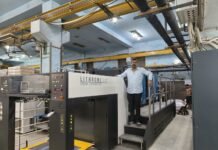The year 2012-13 has been a slowdown year for the computer to plate segment,” says Anil Singh the northern India regional manager of Fujifilm, “and Fujifilm also bore the brunt of the policy changes made in the industry.” Primarily divided in three categories, the computer to conventional plate (CtCP) market is today dominated largely by TechNova after it got the anti-dumping duty legislation passed in 2012 restricting imports from China and the Far East. This legislation affected the sales of Fujifilm and several other producers importing from the East.
“Though this category is strong because conventional plates are cheaper, the ban of imports has led to a sharp fall in sales of CtCP after the year 2012,” says Singh. The other major player in this segment is basysPrint which produces both CtCP as well as UV CTPs and markets its product through Monotech.
The next largest segment is of thermal CtPs where Kodak is the dominant player having introduced low cost models that have generated a growth rate of nearly 20% in output devices. Fujifilm competes in the violet technology segment mainly used by newspapers with its Alinte 8 manual and semi-automatic versions. Sales of this device were affected in the past year. Although Fujifilm sold fewer CtPs in the newspaper segment this year, in the northern region it made a breakthrough in the book segment selling two Alinte units along with its XMF workflow to S Chand and Company, one of the largest domestic educational book publishing companies and another XMF workflow to Advantage, a large commercial printer at Naraina.
Process-less thermal plates
The Brillia High Definition CtP plate range includes both violet and thermal types, which include low- chemistry and process-less variants first introduced in 2007 as environment-friendly options.
Fujifilm is reinforcing its offset plate
portfolio in India by adding the advanced Brillia HD PRO-T3 thermal CtP plate that needs no processor or elaborate chemical process. The new variant Pro-T3 launched globally over a year ago is a high definition process- less thermal CtP plate, well polished, not easily scratch-able — a robust and reliable product. There is a complete elimination of the processor and its associated power, water and chemical use and is the first completely alcohol- free in use plate produced by Fujifilm.
A new micro-graining process applied to the surface of the aluminium enables optimum ink water balance on the press more easily, followed by a second multilayer
coating that provides other necessary functionalities. The Brillia HD Pro-T3 plate is mounted directly on the press and the hardening of the image area takes place on exposure. Laser energy causes polymers in the plate coating to cross link and bond with the plate surface during exposure, thus creating an image on the plate. The areas that do not link are soluble and are removed on press to complete the development. However, since the image is not clearly visible till the development is complete, linearizing and calibration of the CtP requires some effort. Nevertheless, the unbaked run length of the Brillian
Pro-T3 is specified is 100,000 subject to optimum laser power and press quality.
Pressmax chemicals
To ensure smooth trouble free operation of the alcohol free plates it is absolutely necessary to maintain the acidity levels accurately as well as get fount solution chemistry right on press and also ensure perfect cleanliness of the press. To bring about this press environment, Fujifilm has introduced its Pressmax range of environment-friendly press room pre and post treatment chemicals that include washes, coatings, glues, founts, silicones and powders in India. These press room chemicals are designed to provide continued high performance of the Brillia CtP plates.
The coatings are critical to the operation of the Brillia plates and controls the diffusion of oxygen along with a photo sensitive layer that provides high image sensitivity of 120 mJ/cm2 and a resolution of 200 lpi (1- 99%). The removal of the coatings at the start of the press are done by the inks while the fount solution protects the non-image areas. The chemicals are critical to the operation of the Brillia process-less plates and are different from the DSC pressroom chemicals marketed by Fujifilm through Newstech and Singh confirms that the two brands do not have products that compete with each other.












